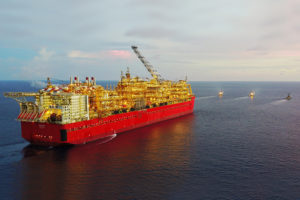Shell’s floating liquefied natural gas (FLNG) facility »Prelude« has officially entered into Lloyd’s Register (LR) class. At 488 m long, 74 m wide and displacing about 600,000 t of water, it is the largest floating offshore facility in the world.
Last month »Prelude« arrived at i[ds_preview]ts operating location in the Browse Basin, offshore northwest Australia, LR informed. It will be moored at a depth of 250 m and will not be dry-docked for the first 25 years of its expected 50-year operational life. The facility required around 260,000 t of steel to build and its turret is the largest ever built. It has been designed to withstand category five cyclones and its technology has generated over 150 patents.

LR has been involved with the project from the start. »Prelude«’s substructure and turret have been designed and constructed in accordance with LR’s Rules for Floating Offshore Installations at a Fixed Location and its topsides certified to an agreed set of industry codes and standards. LR also confirmed compliance of the facility with Shell’s design and engineering practices, where applicable, and the performance standards specified by »Prelude«’s safety case.
Opportunities for improvement of offshore facility inspection
According to LR the intended risk based classification scheme is expected to benefit from use of the latest in remote inspection technologies to gather accurate and repeatable survey data to allow a predictive and focused approach. The LR team in Perth will be welcoming colleagues from LR’s Geoje office in the coming months to assist in the transition from the yard through offshore commissioning to the operations phase.
Jeff Baker, LR’s Offshore Business Development Manager for Australasia, said: »By using the latest in ROV and AUV deployed equipment, we see big opportunities for improvement in the safety, accuracy and manner of offshore facility inspection in service and we anticipate that this will flow on to a new way of approaching classification.«
















